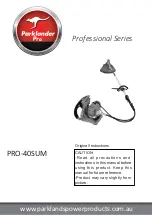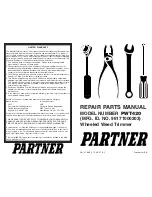
4
IMPORTANT SAFETY
INSTRUCTIONS FOR
BATTERY CHARGERS
SAVE THESE INSTRUCTIONS: This manual
contains important safety instructions for
battery chargers.
• Before using charger, read all instructions
and cautionary markings on charger, battery
pack, and product using battery pack.
WARNING:
Shock hazard. Do not
allow any liquid to get inside charger.
CAUTION:
Burn hazard. To reduce
the risk of injury, charge only designated
BLACK+DECKER batteries. Other types of
batteries may burst causing personal injury
and damage.
CAUTION:
Under certain conditions,
with the charger plugged in to the power
supply, the charger can be shorted by
foreign material. Foreign materials of a
conductive nature such as, but not limited
to, steel wool, aluminum foil, or any buildup
of metallic particles should be kept away
from charger cavities. Always unplug the
charger from the power supply when there
is no battery pack in the cavity. Unplug
charger before attempting to clean.
WARNING:
DO NOT attempt to
charge the battery pack with any
chargers other than the ones in this
manual. The charger and battery pack are
specifically designed to work together.
• These chargers are not intended for any
uses other than charging designated
BLACK+DECKER rechargeable batteries.
Any other uses may result in risk of fire,
electric shock or electrocution.
• Do not expose charger to rain or snow.
• Pull by plug rather than cord when
disconnecting charger. This will reduce
risk of damage to electric plug and cord.
• Make sure that cord is located so that it
will not be stepped on, tripped over, or
otherwise subjected to damage or stress.
• Do not use an extension cord unless
it is absolutely necessary. Use of
improper extension cord could result in
risk of fire, electric shock, or electrocution.
• An extension cord must have adequate
wire size (AWG or American Wire
Gauge) for safety. The smaller the gauge
number of the wire, the greater the capacity
of the cable, that is 16 gauge has more
capacity than 18 gauge. When using more
than one extension to make up the total
length, be sure each individual extension
contains at least the minimum wire size.
Minimum Gauge for Cord Sets
Volts
Total Length of Cord in Feet
120V
0-25 26-50 51-100 101-150
Ampere Rating
More Not more American Wire Gauge
Than Than
0 - 6
18
16
16
14
6 - 10
18
16
14
12
• Do not operate charger with damaged cord
or plug — have them replaced immediately.
• Do not operate charger if it has
received a sharp blow, been dropped,
or otherwise damaged in any way.
Take it to an authorized service center.
• Do not disassemble charger; take it
to an authorized service center when
service or repair is required. Incorrect
reassembly may result in a risk of electric
shock, electrocution or fire.
• Disconnect the charger from the outlet
before attempting any cleaning. This will
reduce the risk of electric shock. Removing
the battery pack will not reduce this risk.
• NEVER attempt to connect 2 chargers
together.
• The charger is designed to operate on
standard household electrical power
(120 Volts). Do not attempt to use it on
any other voltage.
SAVE THESE
INSTRUCTIONS
IMPORTANT SAFETY INSTRUCTION
FOR BATTERY PACKS
WARNING:
For safe operation, read this
manual and manuals originally supplied with
appliance before using the charger.
The battery pack is not fully charged out of
the carton. Before using the battery pack and
charger, read the safety instructions below.
Then follow charging procedures outlined.
READ ALL INSTRUCTIONS
• Do not incinerate the battery pack even if
it is severely damaged or is completely
worn out. The battery pack can explode
in a fire. Toxic fumes and materials are
created when battery packs are burned.
• Do not charge or use battery in
explosive atmospheres, such as in the
presence of flammable liquids, gases or
dust. Inserting or removing the battery from
the charger may ignite the dust or fumes.
• If battery contents come into contact
with the skin, immediately wash area
with mild soap and water. If battery liquid
gets into the eye, rinse water over the
open eye for 15 minutes or until irritation
ceases. If medical attention is needed, the
battery electrolyte for Lithium-Ion batteries
is composed of a mixture of liquid organic





































